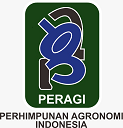INVENTARISASI JAMUR PATOGEN TULAR-BENIH PADA LIMA VARIETAS PADI
Abstract
Penelitian ini bertujuan untuk mengetahui (1) beragam spesies jamur patogen tular-benih pada lima varietas padi, dan (2) persentase daya kecambah lima varietas padi. Penelitian dilaksanakan di Laboratorium Karantina Pertanian Kelas I Semarang, dari bulan Maret sampai dengan Mei 2019. Penelitian ini menggunakan Rancangan Acak Lengkap dengan 5 perlakuan dan 5 ulangan, perlakuan terdiri atas Varietas Inpago Unsoed 1, Inpago Unsoed Parimas, IR64, Ciherang, dan Situ Bagendit. Isolasi dan identifikasi jamur patogen tular-benih dilakukan pada blotter test dan medium PDA, dengan pengamatan di bawah mikroskop stereo dan kompon, kemudian dibandingkan dengan pustaka. Variabel yang diamati yaitu morfologi koloni patogen, morfologi patogen, dan daya kecambah. Hasil penelitian menunjukkan bahwa (1) pada semua varietas benih padi terdapat jamur patogen tular-benih, tetapi tidak semua jamur tersebut dijumpai pada setiap varietas. Jenis jamur patogen tular-benih yang dijumpai, yaitu Alternaria padwickii Ganguly, Aspergillus flavus Link, Aspergillus niger van Tieghem, Curvularia lunata (Wakker) Boedjin, Curvularia pallescens Boedjin, Drechslera oryzae Breda de Haan, Fusarium semitectum Berk. & Rav. [W&R, G,B,J], Rhizoctonia solani J. G. Kuhn, Rhizopus oryzae Went & Prins. Geerl., dan Tilletia barclayana Bref., dan (2) uji daya kecambah menunjukkan bahwa masing-masing varietas benih padi memilki persentase daya kecambah benih yang berbeda. Daya kecambah benih berturut-turut pada varietas IR64, Ciherang, Inpago Unsoed 1, Inpago Unsoed Parimas, dan Situ Bagendit sebesar 85,75, 81,75, 80,25, 76,5, dan 70%.
DOI: 10.37637/ab.v3i1.416
Keywords
Full Text:
PDFReferences
Abadi, A. (2003). Ilmu Penyakit Tumbuhan. Bayu Media.
Agarwal, P. C., Mortensen, C. N., & Mathur, S. B. (1989). Seed-borne Diseases and Seed Health Testing of Rice. Commonwealth Mycological Institute. UK. 106 pp.
Alcaide-Molina, M., Ruiz-Jiménez, J., Mata-Granados, J. M., & Luque de Castro, M. D. (2009). High through-put aflatoxin determination in plant material by automated solidphase extraction on-line coupled to laser-induced fluorescence screening and determination by liquid chromatography-triple quadrupole mass spectrometry. J Chromatogr A, 1216(7), 1115–1125.
Amteme, K., & Tefa, A. (2018). Identifikasi Cendawan Patogen pada Beberapa Varietas Benih Padi Sawah Berdasarkan Model Penyimpanan. Savana Cendana, 3(01), 4–7. https://doi.org/10.32938/sc.v3i01.150
Benoit, M. A., & Mathur, S. B. (1970). Identifiacation of Curvularia on rice seed. Proc. Int. Seed Test. Ass., 35(1), 99–119.
Booth, C. (1971). The Genus Fusarium. Commonwealth Mycological Institute. England. 128 pp.
Campbell, C. K., Jhonson, E. M., & Warnock, D. (2013). Identification of Pathogenic Fungi, (Second Edi). Wiley-Blackwell. Hoboken. 337 pp.
Cheraghian, A. (2019). A Guide for Diagnosis and Direction of Quarantine Pests Black Smut of Rice Tilletia barclayana (Bref.) Sacc. & P. Syd. Basidiomycota: Tilletiaceae. Bureau of Plant Pest Surveillance and Pest Risk Analysis.
Cram, M. M., & Fraedrich, S. W. (2010). Seed diseases and seedborne pathogens of North America. Tree Planters’ Notes, 53(2), 35–44.
Desjardins, A. E., Manandhar, H. K., Plattner, R. D., Manandhar, G. G., Poling, S. M., & Maragos, C. M. (2000). Fusarium species from nepalese rice and production of mycotoxins and gibberellic acid by selected species. Applied and Environmental Microbiology, 66(3), 1020–1025. https://doi.org/10.1128/AEM.66.3.1020-1025.2000
Dijksterhuis, J., & Wosten, H. (2013). Development of Aspergillus niger. CBS-KNAW. Netherlands. 96 pp.
Ellis, M. B. (1997). Dematiaceous Hypomycetes. Commonwealth Mycological Institute. England. 604 pp.
Elshafey, R. A. S. (2018). Biology of rice kernel smut disease causal organism Tilletia barclayana and its molecular identification. Journal of Phytopathology and Pest Management, 5(2), 108–128.
Gonzales, P., Gonzales, E., Huelma, C., Almodiel, M., & Dumlao, J. (2014). Fungi – rice. IRRI, Seed Health Unit, Los Banos, Philippines.
Halindra, Y. M., Rusmiyanto, E., & Linda, R. (2017). Perkecambahan Benih Padi (Oryza sativa L.) Lokal Asal Kalimantan Barat Berdasarkan Tingkat Salinitas. Jurnal Protobiont, 6(3), 295–302.
Hausufa, A., & Rusae, A. (2018). Cendawan Patogen pada Beberapa Varietas Jagung di Kabupaten Timor Tengah Utara. Savana Cendana, 3(02), 21–23. https://doi.org/10.32938/sc.v3i02.153
Ibeabuchi, C., & Olawuni, I. (2011). Isolation and identification of spoilage fungi associated with rice (Oryzae sativa), millet (Pennisetum americanum) and soybean. International Journal of Agriculture and Rural Development, 14(2), 614–616.
ISTA. (1996). International Rules for Seed Testing, Rules 1996. Seed Science and Technology 24 (supplement). Zurich, Switzerland.
Kwon, J.-H., Kim, J., Lee, Y.-H., & Shim, H.-S. (2010). Soft Rot on Cucumis melo var. makuwa Caused by Rhizopus oryzae . Mycobiology, 38(4), 336. https://doi.org/10.4489/myco.2010.38.4.336
Mathur, S. B., & Kongsdal, O. (2003). Common Laboratory Seed Health Testing Methods for Detecting Fungi. Bassedorf (CH): International Seed Testing Assosiation. 275 pp.
Mew, T. W., & Gonzalez, P. (2002). A Handbook of Rice Seed-borne Fungi. IRRI. Los Banos. 83 pp.
Miransari, M., & Smith, D. L. (2014). Plant hormones and seed germination. Environmental and Experimental Botany, 99, 110=121. https://doi.org/0.1016/j.envexpbot.2013.11.005
NAPPO. (2014). NAPPO Standards for Phytosanitary Measures ( RSPM ) A Harmonized Procedure for Morphologically Distinguishing Teliospores of Karnal Bunt from Ryegrass Bunt , Rice Smut and Similar Smuts. The Secretariat of the North American Plant Protection Organization. America 12 p.
Navi, S. S., Singh, S. D., Lenne, J. M., Kirk, P. M., & Brayford, D. (1999). New grain mold fungi of sorghum in India. Journal of Mycology and Plant Pathology, 27, 104–105.
Ngittu, Y. S., Mantiri, F. R., Tallei, T. E., Febby, D., & Kandou, E. F. (2014). Identifikasi genus jamur Fusarium yang menginfeksi eceng gondok (Eichhornia crassipes) di Danau Tondano. Pharmacon Jurnal Ilmiah Farmasi, 3(3), 2302–2493.
Ningsih, R., Mukarlina, & Linda, R. (2012). Isolasi dan identifikasi jamur dari organ bergejala sakit pada tanaman jeruk siam (Citrus nobilis var. microcarpa). Probiont, 1(1), 1–7.
Nuryanto, B. (2017). Penyakit Hawar Pelepah (Rhizoctonia solani) pada Padi dan Taktik Pengelolaannya. Jurnal Perlindungan Tanaman Indonesia, 21(2), 63. https://doi.org/10.22146/jpti.22494
Ou, S. H. (1985). Rice Diseases. Commonwealth Mycological Institute. Kew Surrey. England. 411 pp.
Pratiwi, N. W., Juliantari, E., & Napsiyah, L. K. (2016). Identifikasi Jamur Penyebab Penyakit Pascapanen pada Beberapa Komoditas Bahan Pangan. Jurnal Riau Biologia, 1(14), 86–94.
Quintana, L., Gutierrez, S., Maidana, M., Arriola, M., & Ortiz, A. (2017). Morphological characterization of Alternaria padwickii in rice leaves (Oryza sativa L.) and its prevalence in the departments of itapua, misiones and caazapa. IJAR, 5(15), 1109–1112.
Ramdan, E. P., & Kalsum, U. (2017). Inventarisasi cendawan terbawa benih padi, kedelai, dan cabai. Jurnal Pertanian Presisi, 1(1), 48–58.
Salleh, B., Safinat, A., Julia, L., & Teo, C. H. (1996). Brow spot caused by Curvularia spp. a new disease of asparagus. Biotropia, 90(9), 26–37.
Saylendra, A. (2010). Identifikasi cendawan terbawa benih padi dari Kecamatan Ciruas Kabupaten Serang Banten. Jurnal Agroekotek, 2(2), 24–27.
Semangun, H. (2008). Penyakit-Penyakit Tanaman Pangan di Indonesia. Gadjah Mada University Press. Yogyakarta. 449 hal.
Sucipto, I., Munif, A., Suryadi, Y., & Tondok, E. T. (2015). Eksplorasi Cendawan Endofit Asal Padi Sawah sebagai Agens Pengendali Penyakit Blas pada Padi Sawah. Jurnal Fitopatologi Indonesia, 11(6), 211–218. https://doi.org/10.14692/jfi.11.6.211
Sumartini. (2011). Penyakit tular tanah (Sclerotium rolfsii dan Rhizoctonia solani) pada tanaman kacang-kacangan dan umbi-umbian serta cara pengendaliannya. Jurnal Litbang Pertanian, 31(1), 27–34.
Uma, V., & Wesely, E. (2013). Seed borne fungi of rice from South Tamil Nadu. J. Acad. Indus. Res, 1(March), 612–614.
Vidotto, F., & Ferrero, A. (2000). Germination behaviour of red rice (Oryza sativa L.) seeds in field and laboratory conditions. Agronomie, EDP Sciences, 20(4), 375–382. https://doi.org/10.1051/agro:2000134.
Watanabe, T. (2018). Pictorial Atlas of Soilbone Fungal Plant Pathogens and Diseases. CRC Press. Florida. 298 pp.
Refbacks
- There are currently no refbacks.


























